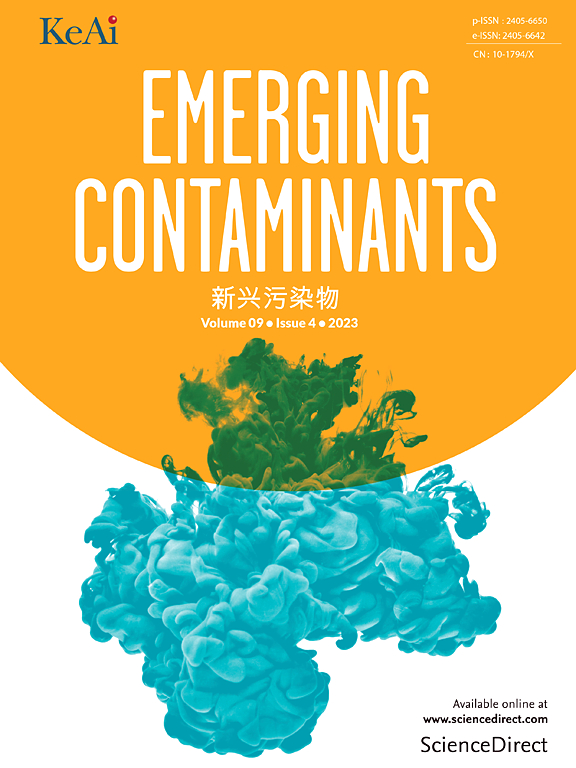N-nitrosamines in karst groundwaters in southwestern China: Risks and implications for drinking water safety
IF 6.9
2区 环境科学与生态学
Q1 ENVIRONMENTAL SCIENCES
引用次数: 0
Abstract
Groundwater is a vital drinking water source for populations in remote karst regions. However, the highly developed karst tube systems facilitate the infiltration of surface wastewater containing N-nitrosamines, raising concerns about groundwater safety. To assess the safety of groundwater and identify which types are safer for consumption, this study investigated N-nitrosamines in various groundwater types, including ground river, karst cavern, well, and mountain spring waters, in Guangxi, a typical karst region in southwestern China. The total concentrations of eight N-nitrosamines in groundwater ranged from 5.1 to 70.3 ng/L, with N-nitrosodiethylamine (NDEA), N-nitrosodimethylamine (NDMA), and N-nitrosopyrrolidine (NPYR) being the dominant species. Ground river water exhibited significantly higher N-nitrosamine concentrations than karst cavern, well, and mountain spring waters. Significant correlations between N-nitrosamines and dissolved inorganic nitrogen suggested their co-emissions from domestic wastewater and the secondary formation potential of N-nitrosamines in groundwater. Redundancy analysis further identified domestic and swine wastewater as the primary sources. Ground river and mountain spring waters posed the highest risks among the four groundwater types, with 30 % and 20 % of sites, respectively, exceeding acceptable cancer risk thresholds. These findings underscore the importance of thorough water treatment before groundwater is used for drinking. Strict livestock farming and domestic wastewater discharge regulations are essential to mitigate contamination risks, particularly in karst areas.
中国西南岩溶地下水中的n -亚硝胺:对饮用水安全的风险和启示
地下水是偏远喀斯特地区居民重要的饮用水源。然而,高度发达的岩溶管道系统促进了含n -亚硝胺的地表废水的渗入,引起了地下水安全问题。为了评价地下水的安全性,确定哪些类型的地下水更安全,本研究以中国西南典型喀斯特地区广西为研究对象,对地下河流、岩溶溶洞、井、山泉等不同类型地下水中的n -亚硝胺进行了研究。地下水中8种n -亚硝胺的总浓度在5.1 ~ 70.3 ng/L之间,以n -亚硝基二乙胺(NDEA)、n -亚硝基二甲胺(NDMA)和n -亚硝基吡啶(NPYR)为优势种。地下水中n -亚硝胺的浓度显著高于溶洞水、井水和山泉水。n -亚硝胺与溶解无机氮之间存在显著的相关性,表明它们在生活废水中的共排放和地下水中n -亚硝胺的二次形成潜力。冗余分析进一步确定了生活污水和养猪废水为主要来源。在四种地下水类型中,地下河流和山泉的风险最高,分别有30%和20%的地点超过了可接受的癌症风险阈值。这些发现强调了在地下水用于饮用之前进行彻底水处理的重要性。严格的畜牧业和家庭污水排放法规对于减轻污染风险至关重要,特别是在喀斯特地区。
本文章由计算机程序翻译,如有差异,请以英文原文为准。
求助全文
约1分钟内获得全文
求助全文
来源期刊

Emerging Contaminants
Medicine-Public Health, Environmental and Occupational Health
CiteScore
10.00
自引率
6.70%
发文量
35
审稿时长
44 days
期刊介绍:
Emerging Contaminants is an outlet for world-leading research addressing problems associated with environmental contamination caused by emerging contaminants and their solutions. Emerging contaminants are defined as chemicals that are not currently (or have been only recently) regulated and about which there exist concerns regarding their impact on human or ecological health. Examples of emerging contaminants include disinfection by-products, pharmaceutical and personal care products, persistent organic chemicals, and mercury etc. as well as their degradation products. We encourage papers addressing science that facilitates greater understanding of the nature, extent, and impacts of the presence of emerging contaminants in the environment; technology that exploits original principles to reduce and control their environmental presence; as well as the development, implementation and efficacy of national and international policies to protect human health and the environment from emerging contaminants.
 求助内容:
求助内容: 应助结果提醒方式:
应助结果提醒方式:


